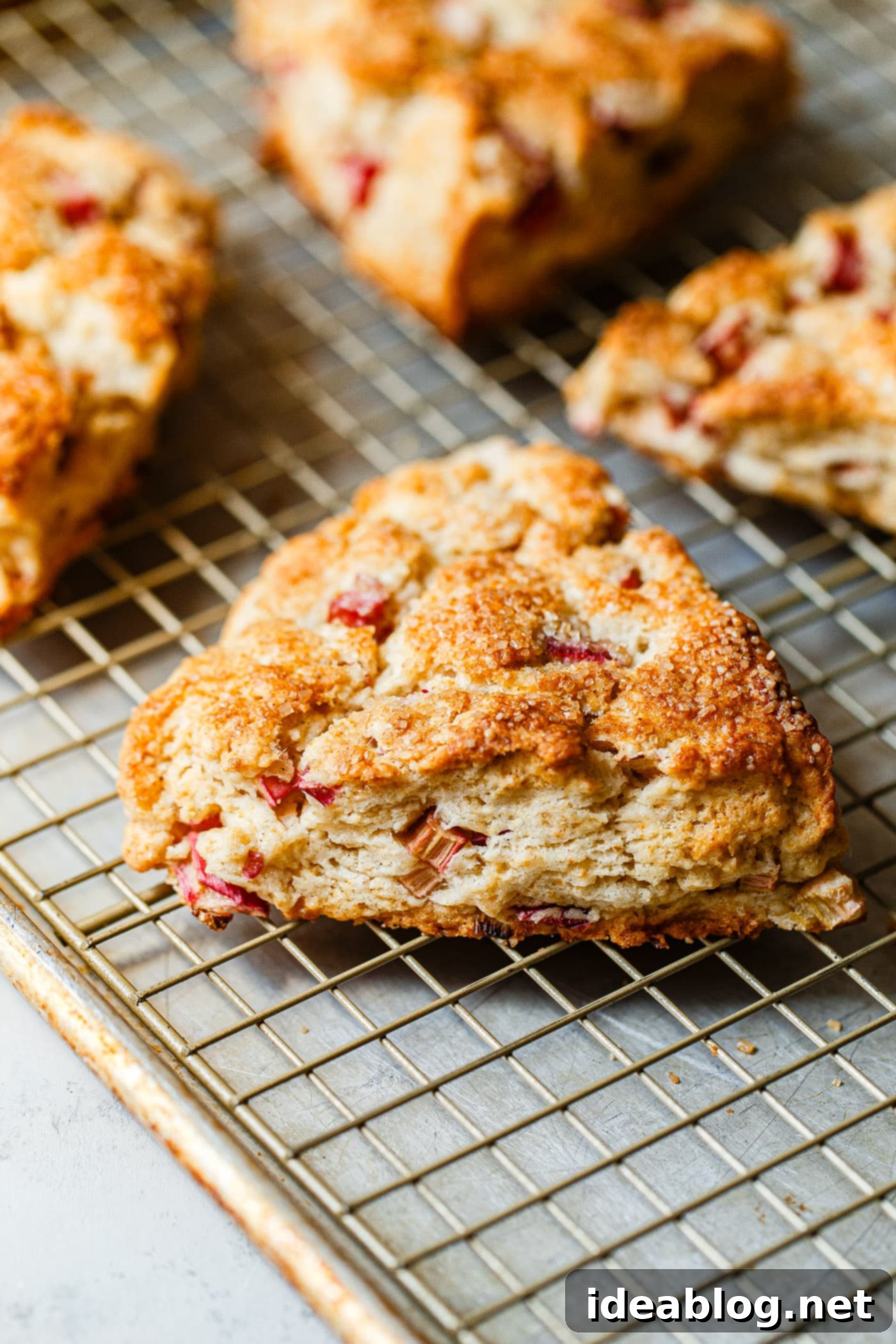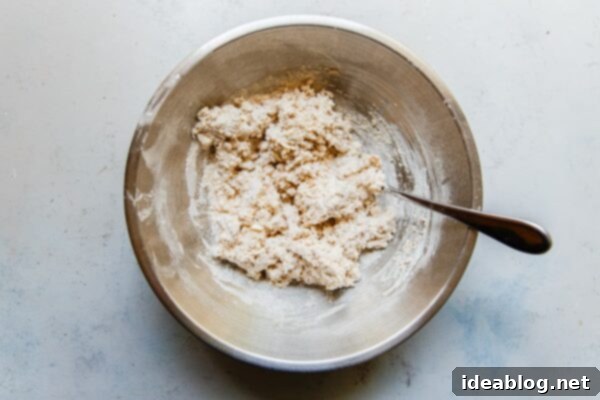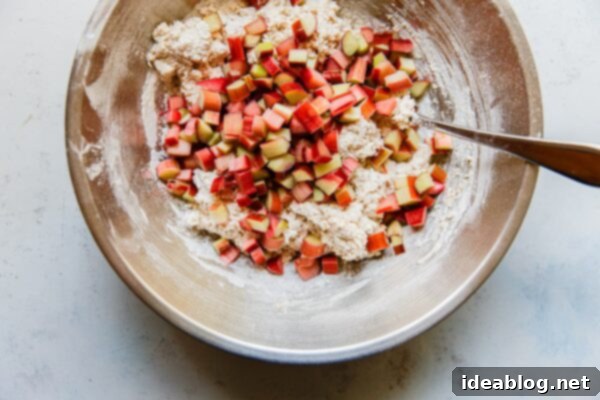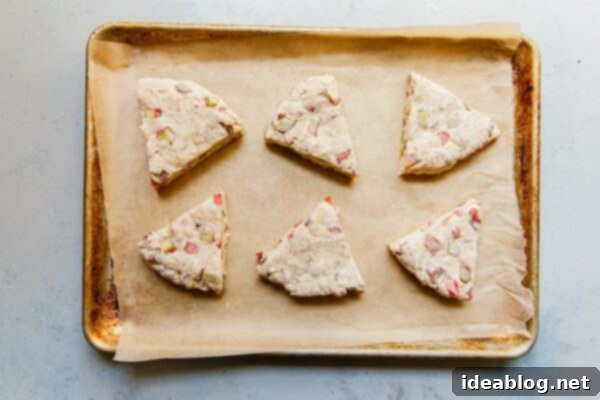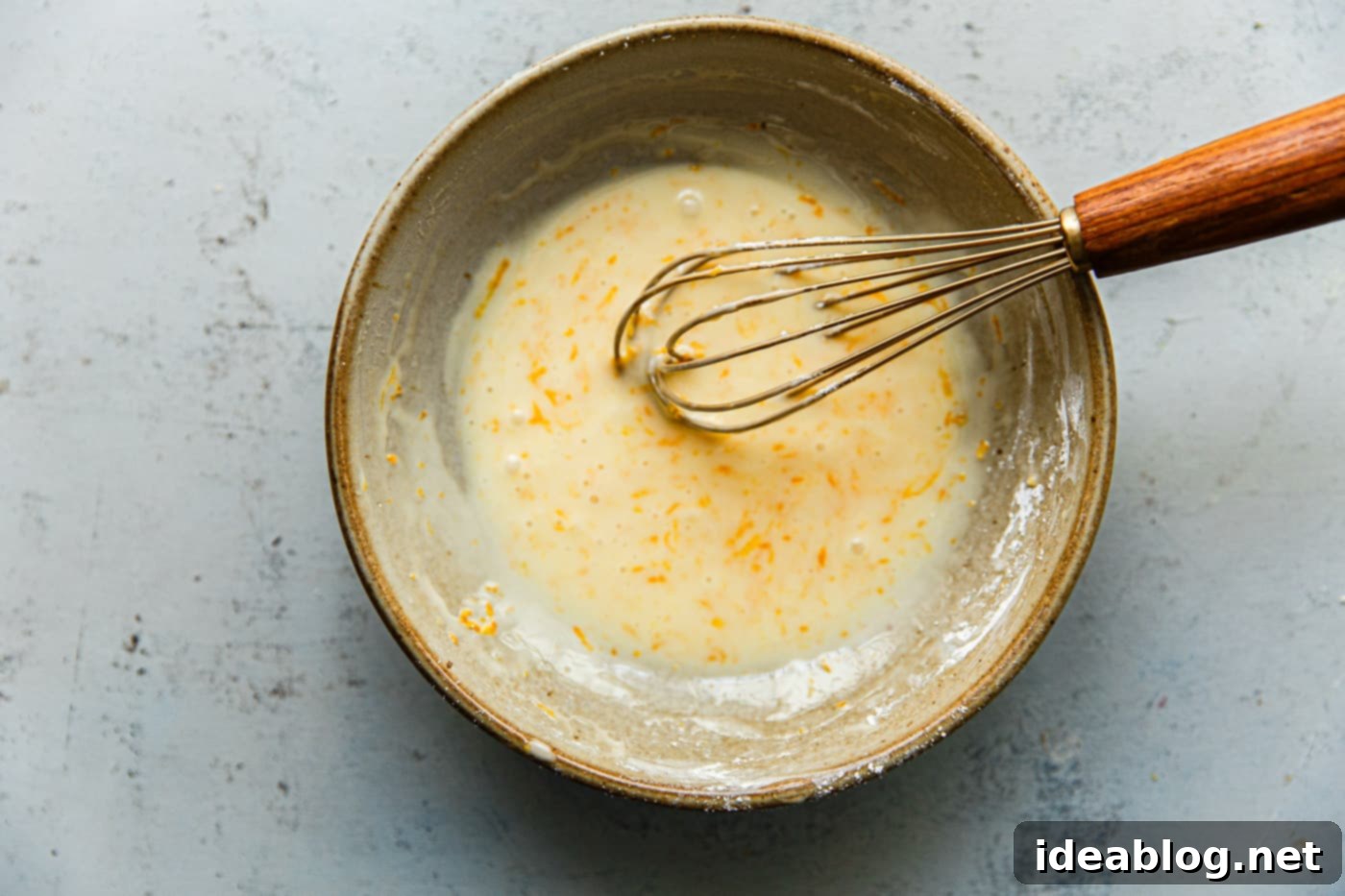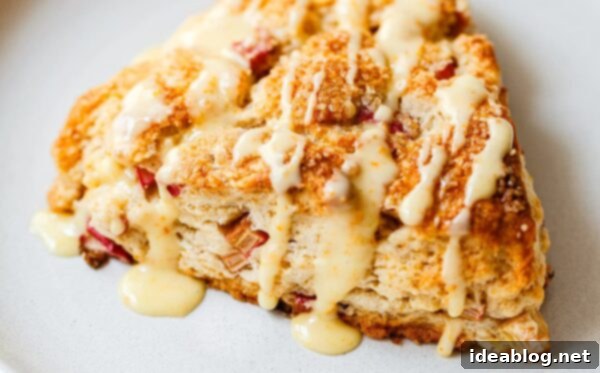Delicious Rhubarb Scones with Zesty Orange Glaze: Your Essential Guide to Seasonal Baking
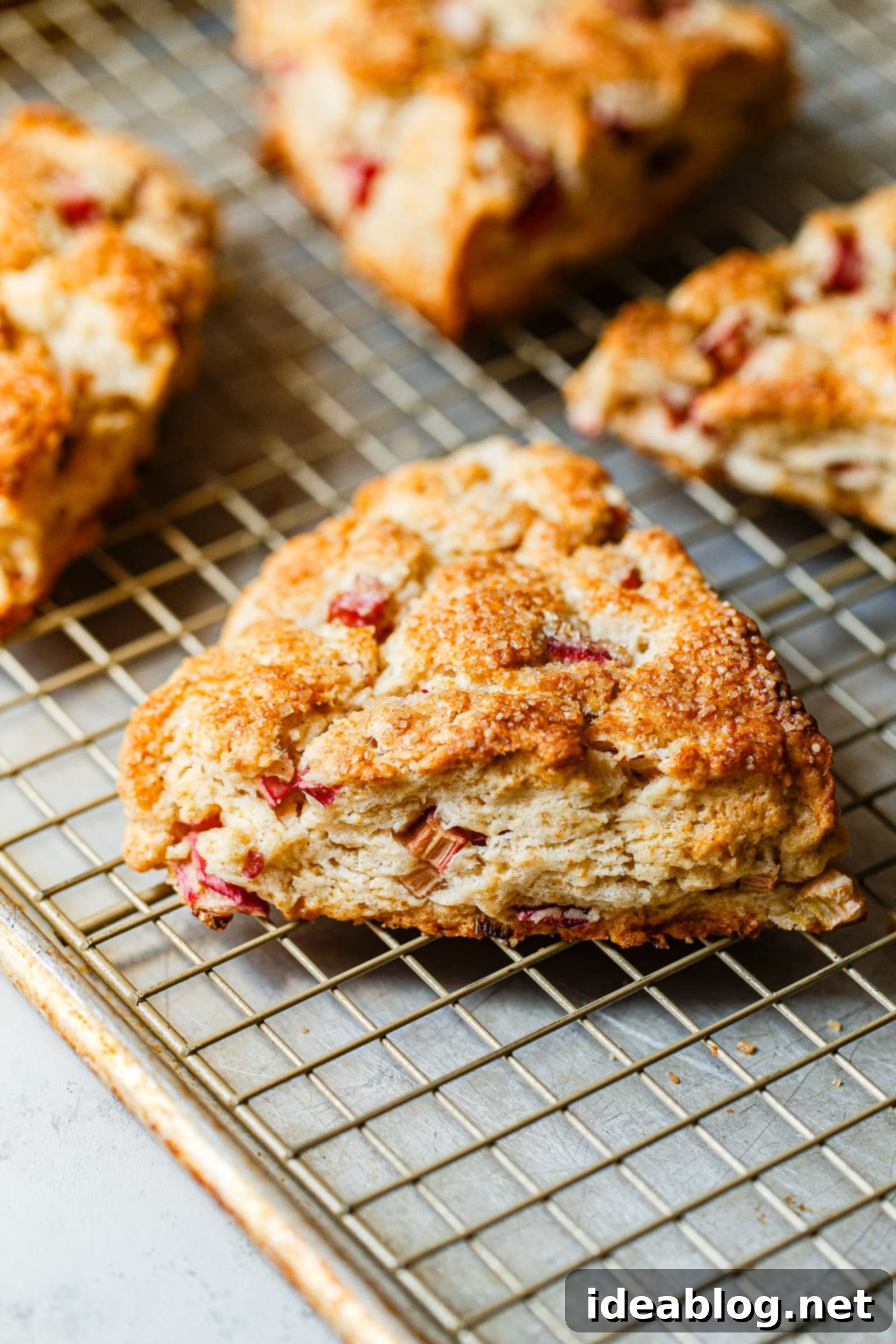
Embrace the vibrant flavors of spring and summer with these absolutely irresistible Rhubarb Scones with Orange Glaze. Seasonal baking brings such a unique joy, and discovering new ways to incorporate fresh ingredients like rhubarb into our favorite treats is truly rewarding. This particular scone recipe has not only met but truly exceeded all my expectations, delivering a delightful blend of tartness, spice, and citrusy sweetness in every bite.
At the heart of this recipe lies my tried-and-true scone dough formula, a method perfected over years of baking. The secret to its incredible texture is a meticulous combination of intensely cold unsalted butter and well-chilled heavy cream. This careful approach ensures that each scone emerges from the oven with a wonderfully tender, moist crumb, complemented by exquisitely crisp and buttery edges. Throughout this perfect pastry, you’ll discover generous pieces of tangy rhubarb, providing a delightful burst of flavor that cuts through the richness beautifully.
To elevate these delightful scones even further, they are generously crowned with a luminous, fragrant, and zesty orange glaze. The bright, sweet notes of fresh orange are a match made in heaven for the distinct tartness of the rhubarb, creating a harmonious flavor profile that will tantalize your taste buds. This beautiful glaze not only adds a burst of sweetness but also a lovely aromatic finish, making these scones truly unforgettable.
One of the many charms of this recipe is its straightforward preparation and remarkably short bake time. This means you can easily whip up a batch of these delectable scones at a moment’s notice, perfect for an impromptu brunch, a last-minute tea party, or simply to satisfy a sudden craving for something truly special. For ultimate convenience and to ensure you can enjoy these scones whenever the mood strikes, I’ve also included comprehensive instructions below for both reheating baked scones and freezing the dough for future baking.
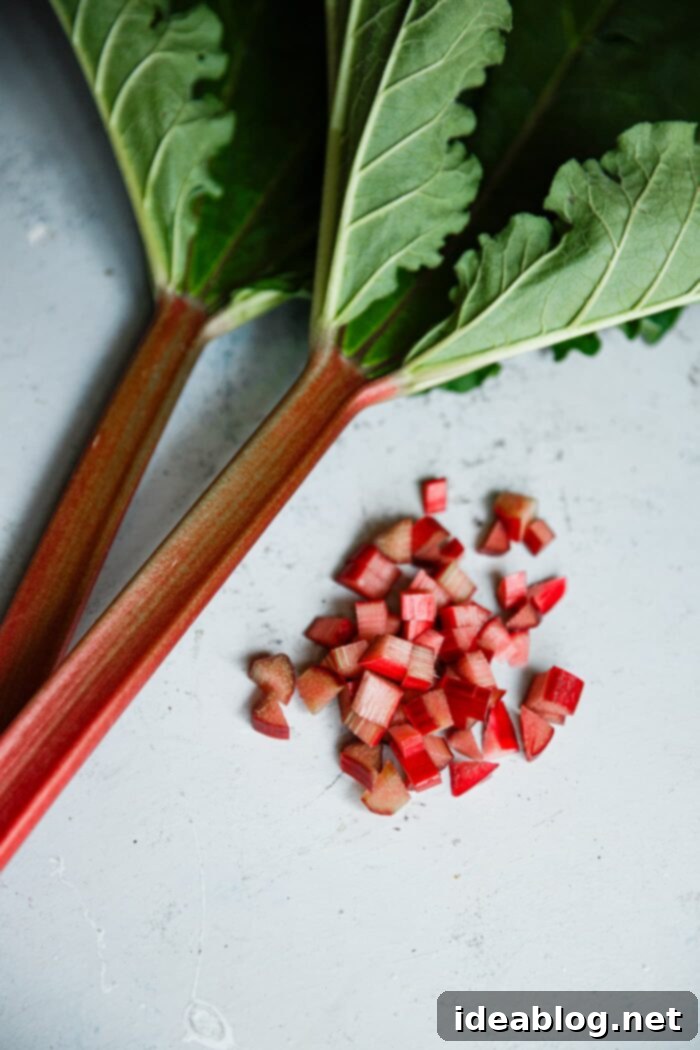
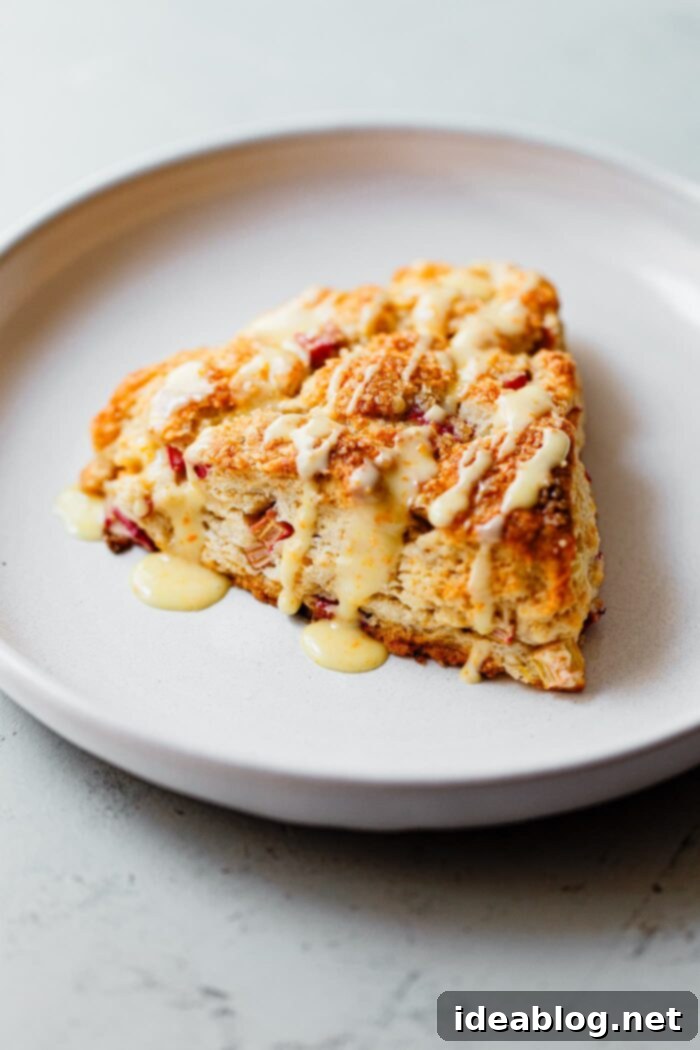
Why You’ll Absolutely Adore These Rhubarb Scones:
- Quick & Effortless Preparation – Scones are a truly fantastic choice for breakfast or brunch pastries precisely because of their minimal fuss. Unlike many other baked goods that require extensive proofing or complex techniques, you can whip up a batch of these glorious rhubarb scones with very little advance preparation. The process is straightforward, making them accessible even for novice bakers, and a delicious treat is never far away. From mixing to baking, the steps are designed for efficiency without compromising on quality or flavor.
- Achieve the Perfect Scone Texture Every Time – Sadly, scones have, over the years, sometimes garnered an unfair reputation due to poorly executed recipes resulting in dry or dense pastries. This recipe is specifically engineered to combat that perception, guaranteeing an ideal scone experience. You’ll be delighted by a tender, moist interior that practically melts in your mouth, perfectly contrasted by crisp, golden-brown, buttery edges. The interplay of these textures, combined with the soft tartness of the rhubarb, creates a truly harmonious and satisfying bite that will convert any scone skeptic.
- Incredibly Easy to Reheat & Perfect for Meal Prepping – The convenience factor of these rhubarb scones is truly outstanding. They reheat beautifully, allowing you to enjoy that fresh-baked warmth and flavor even a day or two after baking. A key tip for reheating is to skip the glaze until serving, ensuring a perfect texture. Furthermore, for those who love to plan ahead, this scone dough is incredibly versatile. Similar to preparing cookie dough in advance, you can easily prep the scone dough, cut it into wedges, freeze it, and then bake it directly from frozen whenever the craving strikes. This makes them ideal for smaller households where you might not want a full batch at once, or for entertaining, allowing you to serve warm, fresh scones with minimal effort on the day of your gathering.
- Embrace Seasonal Flavors – Rhubarb is a quintessential spring and early summer ingredient, offering a unique tartness that’s unparalleled. This recipe champions the best of the season, allowing you to celebrate fresh produce in a delightful baked form. The combination with zesty orange creates a vibrant flavor profile that truly highlights rhubarb’s distinctive character, making these scones a perfect seasonal indulgence.
- Versatile Serving Options – While undeniably perfect for breakfast or brunch, these rhubarb scones are also magnificent for afternoon tea, as a light dessert, or even a sophisticated snack. Their balanced sweetness and tartness mean they pair wonderfully with a simple cup of coffee or a fragrant herbal tea, making them a versatile addition to any menu.
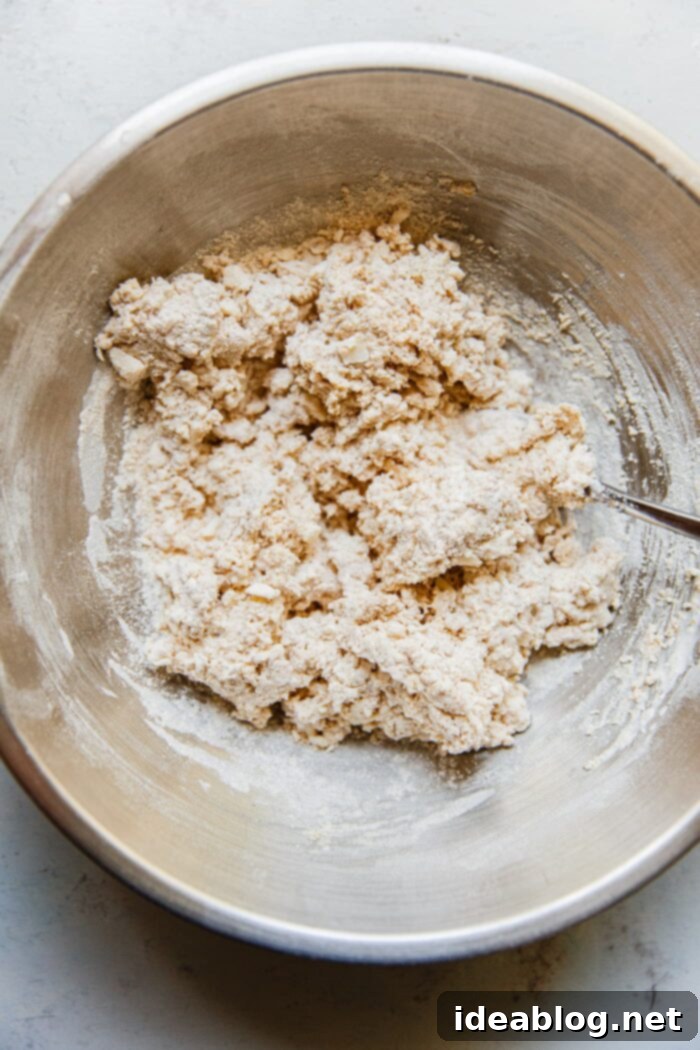
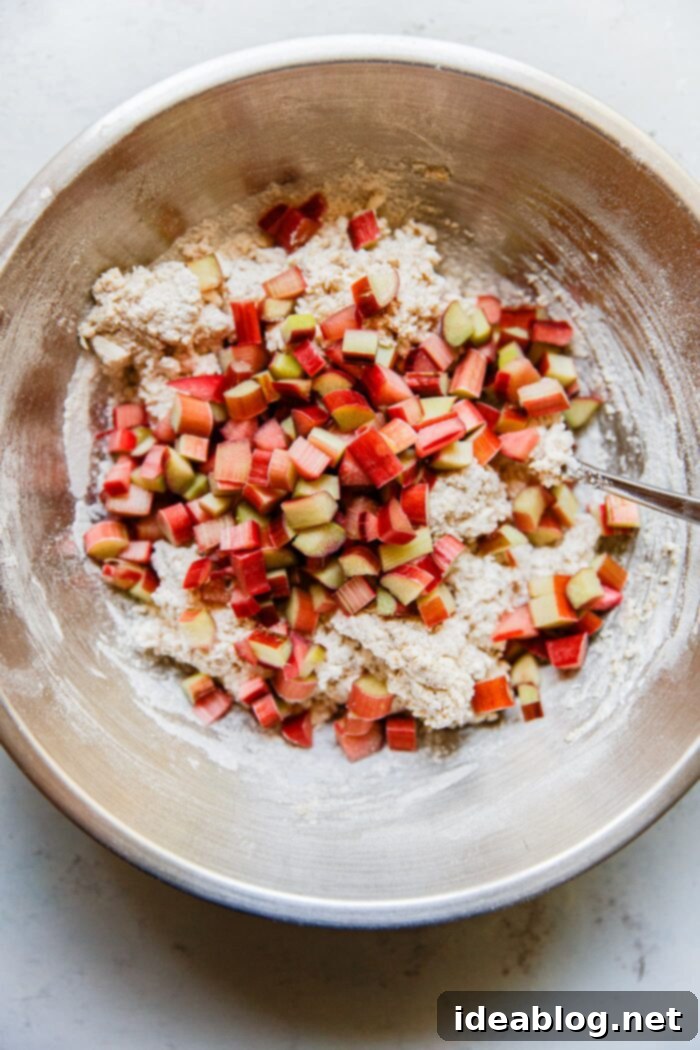
Crafting Your Perfect Rhubarb Scones: A Detailed Guide
Making these glorious rhubarb scones is a straightforward process, especially when you understand the key steps that contribute to their incredible texture and flavor. Follow these instructions carefully for bakery-quality results right in your own kitchen.
- Prepare Your Dry Ingredients and Incorporate Cold Butter: Begin by preheating your oven to 425°F (220°C) and lining a half sheet pan with parchment paper; this step ensures your scones bake evenly and don’t stick. In the bowl of a large food processor (fitted with a blade attachment for best results), combine your dry ingredients: the unbleached all-purpose flour, granulated sugar, aluminum-free baking powder, kosher salt, ground cardamom, and ground cinnamon. Pulse these ingredients several times until they are thoroughly mixed and evenly distributed. The spices add a wonderful warmth that beautifully complements the rhubarb. Next, add the cold unsalted butter, which you should have already cut into ½-inch cubes. Gently toss the butter in the flour mixture to coat each piece lightly. Now, pulse the food processor 10 to 12 times. The goal here is for the butter pieces to be no smaller than the size of a pea. This ensures that as the scones bake, these pockets of butter create steam, resulting in a flaky and tender crumb. Transfer this mixture to a large mixing bowl.
- Combine Wet and Dry Ingredients, Add Rhubarb, and Shape the Dough: Create a shallow well in the center of your dry ingredients in the mixing bowl. Carefully pour in the 1 cup (240g) of cold heavy cream. Using a large fork, gently stir the cream into the dry ingredients. Be mindful not to overmix; the dough should just barely start to come together. As soon as it begins to clump, stir in your diced fresh rhubarb. The cold cream is crucial here as it helps keep the butter solid, contributing to the scone’s flakiness. Scrape the dough out onto a clean, lightly-floured countertop. Press the dough together gently with your hands for just 5 to 10 seconds, being extremely careful to avoid over-working it. Overmixing develops the gluten in the flour, which can lead to tough scones. If the dough feels too sticky or difficult to handle, sprinkle it with a little more flour, but use it sparingly. Pat the dough into an 8-inch diameter disc, aiming for a thickness of roughly 1-inch.
- Cut, Glaze, and Bake Your Scones: Once your dough disc is formed, use a sharp, large knife to cut it into six even wedges. For uniform baking and a beautiful presentation, try to make each wedge as consistent as possible. Carefully transfer these scone wedges to your lined sheet pan, ensuring they are spaced apart by several inches to allow for even heat circulation. Before baking, use a pastry brush to lightly brush the tops of the scones with an additional 2 tablespoons (30g) of heavy cream. This helps them achieve a beautiful golden-brown crust. Finish by generously sprinkling the tops with demerara or turbinado sugar; this adds a lovely sparkle and a pleasant textural crunch to the exterior. Bake the scones for 18 to 20 minutes, or until they are beautifully golden brown on top and cooked through. Once baked, remove the sheet pan from the oven and allow the scones to cool on the pan for about 5 minutes. Then, transfer them to a wire rack to cool completely before you apply the glaze. This cooling period is essential for the glaze to set properly.
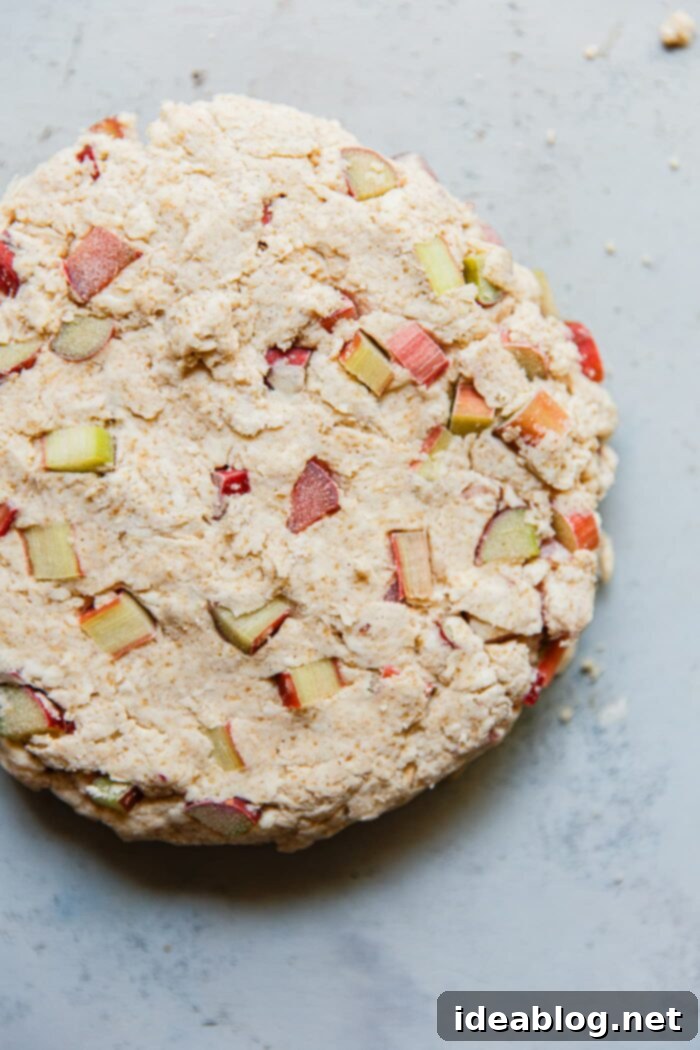
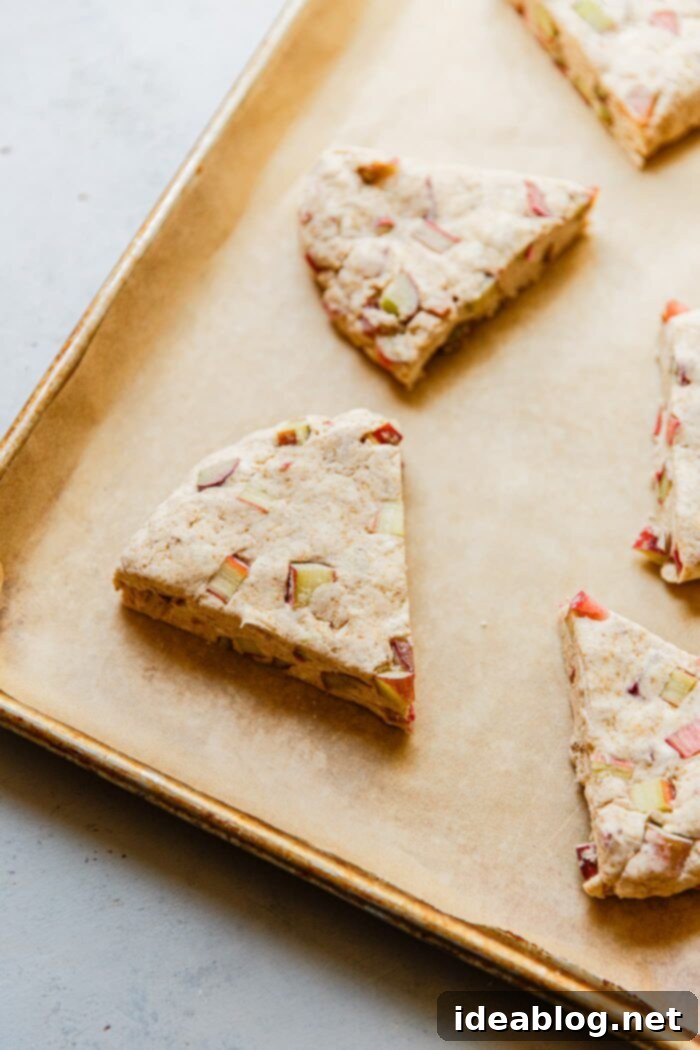
Mastering the Zesty Orange Glaze
The bright, citrusy orange glaze is the perfect finishing touch for these rhubarb scones, offering a sweet and aromatic counterpoint to the tart rhubarb. To prepare it, simply whisk together the sifted powdered sugar, fresh orange zest, and 1 tablespoon of freshly squeezed orange juice in a small bowl. The key is to achieve a consistency that is thick enough to cling to the scones but still thin enough to be drizzled attractively from the end of a spoon. If your glaze seems too thick, add an additional 1-2 teaspoons of orange juice, a tiny bit at a time, until it reaches the desired drizzly consistency. Conversely, if it’s too thin, incorporate another tablespoon (or more, as needed) of sifted powdered sugar until it thickens up. Once your scones are completely cooled, use a spoon to generously drizzle the glaze over their tops. Allow the glaze a few minutes to set slightly before serving to prevent a sticky mess. This quick and easy glaze truly elevates the entire scone experience!
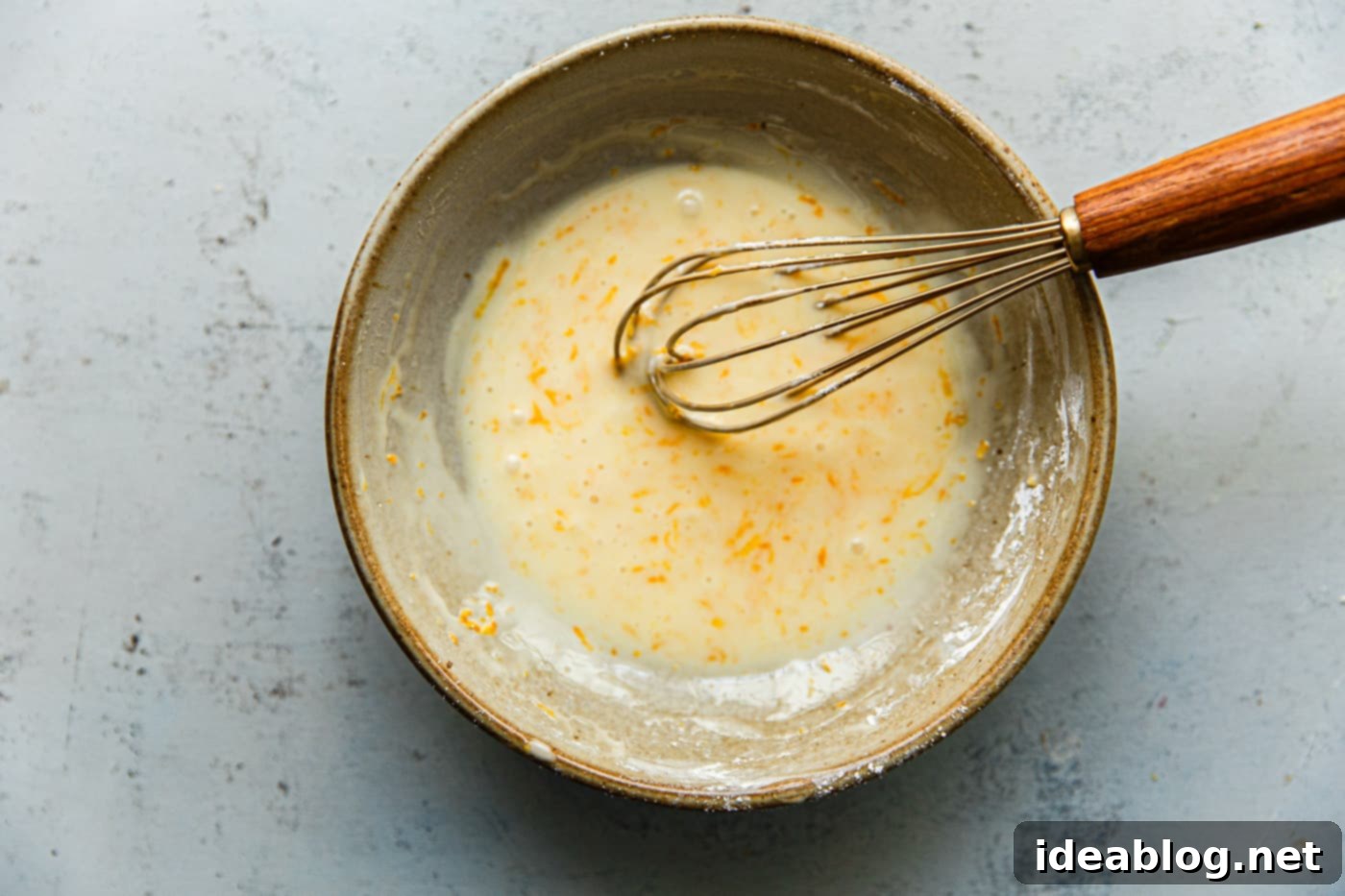
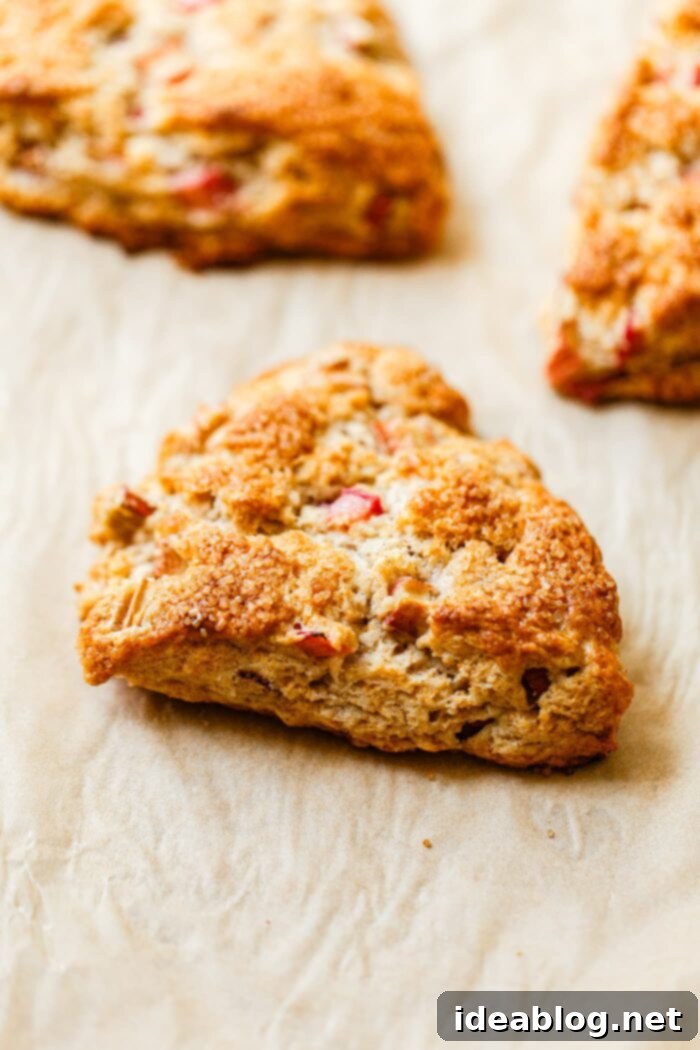
Top Tips for Perfect Scones Every Time
- Keep Ingredients Cold: This is the golden rule for flaky scones. Cold butter creates pockets of steam, which in turn leads to a light and airy texture. Ensure your butter, cream, and even your rhubarb are well-chilled before you start.
- Don’t Overmix the Dough: Gentle handling is key. Overmixing develops gluten, which results in tough, dense scones. Mix just until the ingredients come together, and no more. A shaggy dough is a happy dough!
- Measure Accurately: Especially with baking, precision matters. Use a kitchen scale for flour if possible, or the spoon-and-level method to ensure you’re not adding too much.
- Use Quality Rhubarb: Fresh, firm rhubarb stalks will give the best flavor and texture. Avoid any stalks that are soft or stringy.
- Sharp Knife for Cutting: A sharp knife creates clean cuts, which helps the scones rise better and prevents them from spreading too much during baking.
- Cool Completely Before Glazing: Applying glaze to warm scones will cause it to melt and run off, rather than set into a beautiful, glossy finish. Patience is a virtue here!
How to Reheat Baked Rhubarb Scones:
While these Rhubarb Scones are undoubtedly at their peak freshness the day they are baked, they can absolutely be enjoyed later with just a little care. If you plan on preparing a batch of these delicious scones a day or two in advance, it is crucial that you do not glaze them immediately. This simple step is vital because it allows you to properly reheat the scones in the oven, bringing back their delightful texture without compromising the glaze. The glaze should always be applied fresh, just before serving, for the best appearance and taste.
- Detailed Reheating Instructions for Scones: To revive your unglazed, baked scones, begin by preheating your oven to a moderate 350ºF (176ºC). Arrange the scones evenly on a parchment-lined sheet pan. Bake them for approximately 10 to 12 minutes, or until they are warmed through and the edges have crisped up slightly again. Once reheated, transfer the scones to a wire rack to cool for a few minutes. While they cool, you can quickly prepare the orange glaze (if you haven’t already). Drizzle the fresh glaze over the still-warm (but not hot) scones and serve immediately for a truly wonderful experience that rivals freshly baked.
How to Freeze Rhubarb Scones Dough and Bake from Frozen:
For ultimate convenience and to enjoy fresh-baked scones whenever you desire, preparing the dough ahead of time and freezing it is a fantastic option. This method is perfect for busy mornings, unexpected guests, or simply when you want to enjoy a warm treat without the full preparation time.
- Freezing Scone Dough: After you have prepared the scone dough according to the recipe instructions and cut it into six individual wedges, place these unbaked wedges on a parchment-lined sheet pan, ensuring they are not touching each other. Place the entire sheet pan into the freezer and allow the scones to freeze completely until solid. This usually takes a few hours. Once they are rock-solid, transfer the frozen scone wedges to a large, heavy-duty Ziplock bag or an airtight freezer-safe container. Make sure to squeeze out any excess air from the bag before sealing it tightly to prevent freezer burn. The scone dough can be stored in the freezer for up to one month, ready for baking at your leisure.
- Baking Scones Directly from Frozen: When you’re ready to bake, there’s no need to thaw the dough! Preheat your oven to a slightly higher temperature of 425ºF (220°C). Place the frozen scones directly onto a parchment-lined sheet pan, spaced a few inches apart. Bake them for approximately 20 to 22 minutes. Because they are starting from frozen, they will require a slightly longer baking time than fresh dough. They are done when they are golden brown and puffed up beautifully. Transfer the baked scones to a wire rack to cool. While they are cooling, prepare your fragrant orange glaze and drizzle it over the cooled scones before serving. This method ensures you can enjoy warm, delicious, homemade rhubarb scones with minimal effort, even on the busiest of days.
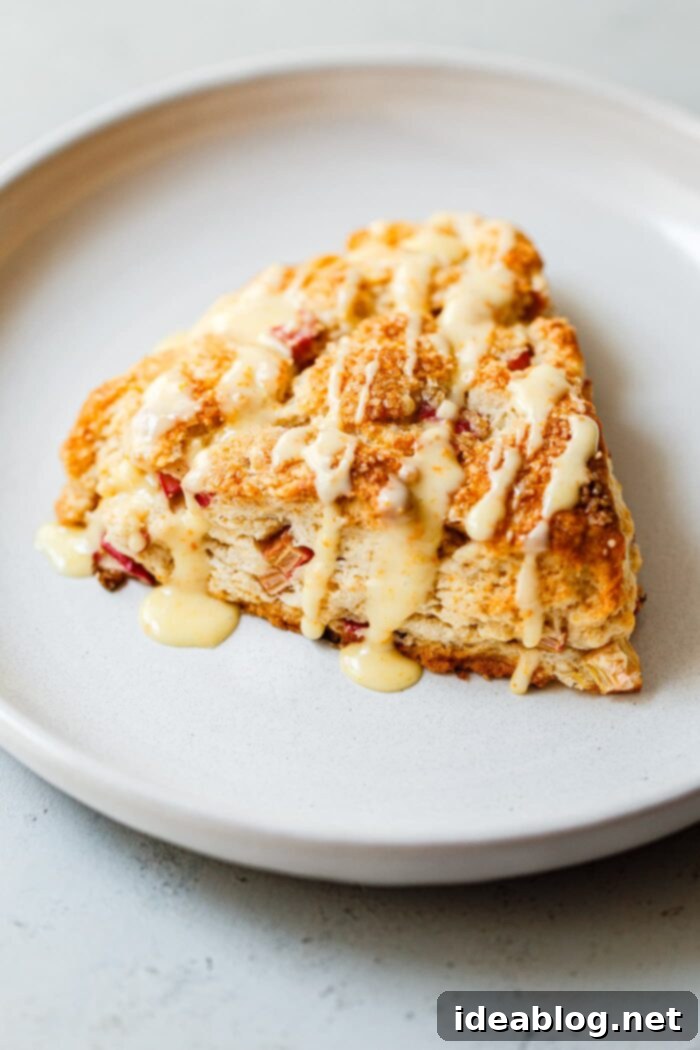
More Delicious Scone Recipes to Explore:
If you’ve fallen in love with these delightful Rhubarb Scones, you’ll be thrilled to discover other wonderful variations to satisfy your scone cravings. Each recipe offers a unique flavor profile while maintaining that coveted tender crumb and crisp exterior.
- Raspberry Pistachio Scones: A vibrant combination of sweet raspberries and nutty pistachios, finished with a bright lemon glaze.
- Orange Chocolate Chunk Scones: Indulge in rich chocolate chunks paired with zesty orange, all topped with a complementary orange glaze.
- Brown Butter Chocolate Chip Scones: A sophisticated take on a classic, featuring the deep, nutty flavor of brown butter and beloved chocolate chips.
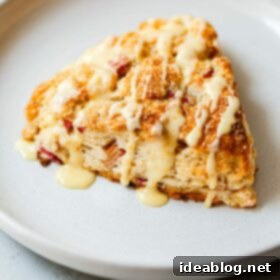
Rhubarb Scones with Orange Glaze
Pin
Review
SaveSaved!
To elevate them further, the scones are topped with a zesty and fragrant orange glaze. The fresh orange complements the rhubarb beautifully and adds a burst of sweetness to each bite. These scones are best served the day they are baked, but they reheat beautifully (just skip the glaze!) and can also be baked from frozen. See the full instructions in the recipe note section.
Equipment
-
Large Food Processor
Ingredients
- 2 cups (240g) unbleached all purpose flour
- 3 tablespoons (36g) granulated sugar
- 1 tablespoon (14g) baking powder aluminum free
- ½ teaspoon kosher salt
- ¾ teaspoon ground cardamom
- ¼ teaspoon ground cinnamon
- 8 tablespoons (4 oz;115g) cold unsalted butter cut into ½-inch cubes
- 1 cup (240g) cold heavy cream plus roughly 2 tablespoons (30g) for brushing
- 7 ounces (200g) fresh rhubarb cut into ½-inch dice (roughly 2 medium stalks)
- 2 tablespoons (14g) demerara or turbinado sugar for sprinkling
Orange Glaze:
- ¾ cup (90g) powdered sugar sifted
- 1 teaspoon fresh orange zest
- 1 tablespoon + 1-2 teaspoons freshly squeezed orange juice
Instructions
-
Preheat the oven to 425°F (220°C) with a rack in the center position. Line a half sheet pan with parchment paper and set aside.
-
Prepare Scones: In a large food processor, fitted with a blade attachment, combine the flour, sugar, baking powder, salt, cardamom, and cinnamon. Pulse several times until all of the ingredients are evenly incorporated. Add cold cubed unsalted butter to the bowl and gently toss in the flour mixture until lightly coated. Pulse 10 to 12 times, or until the butter is no smaller than the size of a pea. Transfer mixture to a large mixing bowl.

-
Create a well in the center of the ingredients, and pour in 1 cup (240g) cold heavy cream. Using a large fork, stir the cream into the dry ingredients. As the dough just starts to clump and come together, stir in the diced rhubarb. Scrape the dough onto a clean, lightly-floured counter-top. Press the dough together gently for 5 to 10 seconds, avoid over-working. Sprinkle with more flour if the dough gets too sticky or difficult to handle. Pat the dough into an 8-inch diameter disc, roughly 1-inch thick.

-
Using a sharp, large knife, cut the dough into six even wedges. Transfer to the lined sheet pan, setting them apart by several inches. Using a pastry brush, brush the tops of the scones with heavy cream, then sprinkle the tops generously with demerara or turbinado sugar. Bake for 18 to 20 minutes or until golden brown. Place on a rack and allow the scones to cool on the sheet pan for 5 minutes, then transfer to a rack to cool completely before glazing.

-
Prepare Orange Glaze: In a small bowl, whisk together the powdered sugar, orange zest, and 1 tablespoon orange juice. It should be thick, but able to be drizzled from the end of a spoon. If the glaze is too thick, add another 1-2 teaspoons of orange juice to thin. If the glaze is too thin, add another tablespoon of powdered sugar (or more, as needed) until it reaches the appropriate consistency.

-
Once the scones have cooled, use a spoon and drizzle the tops of the cooled scones with the glaze. Allow the glaze to set slightly before serving. These scones are best served the day of baking. If you do plan on preparing the scones a day or two in advance, do not glaze the scones and following the reheating instructions in the note section below.

Reheating Instructions:
- These scones are best served the day they are baked. If you do plan on preparing the scones a day or two in advance, do not glaze the scones and follow these reheat instructions: Preheat the oven to 350ºF (176ºC). Place the unglazed, baked scones on a parchment-lined sheet pan and bake for 10 to 12 minutes. Transfer to a rack to cool, then prepare and glaze using the recipe instructions.
Freezing Instructions:
- Alternatively, you can prepare the dough, cut them into wedges, freeze, and bake from frozen using these instructions: Prepare the scone dough, cut into wedges, and set apart on a lined sheet pan. Place in the freezer until solid, then transfer to a large Ziplock bag, excess air squeezed out and sealed well. Freeze for up to a month.
- Bake from Frozen: Preheat the oven to 425ºF (220°C). Place the frozen scones on a parchment-lined sheet pan and bake for 20 to 22 minutes. Transfer to a rack to cool, then prepare and glaze using the recipe instructions.
